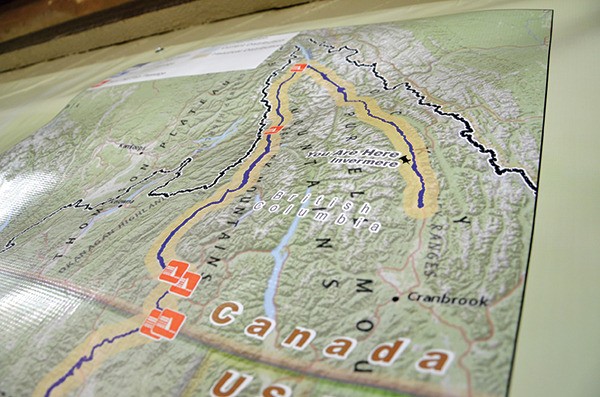Salmon were cut off from the Columbia River in 1942 after the completion of the Grand Coulee Dam, but before the drought of chinook reaches its centennial, the Canadian Columbia River Intertribal Fisheries Commission (CCRIFC) has a plan to bring them back from the ocean.
“The Grand Coulee Dam (in Washington state) was finished in 1942, so that was the last of the salmon,” CCRIFC director Bill Green said at the Columbia Salmon Festival in Invermere on Saturday, September 28th. “We’d like to have them back here in full stock by 2042.”
Another impassable dam, the Chief Joseph, was subsequently built approximately 50 kilometres west of the Grand Coulee. Mr. Green wants to give the salmon a hand in getting past those two major obstacles.
After capturing them at the Chief Joseph, the fish will be transported upstream of the Grand Coulee.
“Then we’ll release them into Roosevelt Reservoir, which is a big reservoir lake, and put radio tags on them to follow them up stream,” he explained. “We’ll see if they find their spawning grounds up here, various little tributaries and the main stem. Then we’ll see if they successfully spawn and we can monitor the survival of the eggs.”
More than a dozen dams lie between Columbia Lake and the Pacific ocean, and six of them prevent the passage of salmon. With help passing only two of those dams, the first phase of the project won’t see the chinook travel much further than the Canada – U.S. border.
“Once the salmon are past the Grand Coulee Dam, they can swim all the way upstream, 60 kilometres as far as the Keenleyside Dam, or 55 kilometres as far as the Brilliant Dam,” he said.
Both dams are in Castlegar, which is far enough into Canada for the project to hold an appropriate title: Experimental Reintroduction of Chinook Salmon to the Transboundary Reach.”
The “trap and truck” method of transporting salmon has been practiced successfully in the past, but never on such a large scale, said Mr. Green. If the project yields positive results, the CCRIFC hope to reintroduce salmon into interior B.C., and eventually the valley.
“Three dams along the way have undergone environmental assessments for hydropower expansion, and when they did that we got them to agree that if we get salmon back to here, they’ll put fish passage ladders and other passage technologies in each of those three dams,” Mr. Green added. “So we have a way forward.”
But before making the pitch for major adjustments on massive dams, the CCRIFC must be thorough in its research, as the group also has to deal with red tape in two countries.
“Once we have information (regarding which specific salmon stocks will be sampled) and present it to the various governments on both sides of the border, and hopefully get approval, then we do that experiment three times over three years and look at the results.”
Working with a First Nations organization, Mr. Green said the Ktunaxa Nation and the Shuswap Band both feel a strong need to have the salmon come back. He said that salmon was one-third of their traditional protein source.
“Their lifestyle was built around the salmon, and they want to build that back,” he said.
He said the group is undertaking the project for that reason and “for all of us to have salmon back and clean healthy water.”
He explained the ecological value in having marine life decompose inland, and said that fertilization programs have since been implemented to replace the nutrients the salmon used to provide.
Author John Ralston Saul, who was the keynote speaker at the Columbia Salmon Festival at Fairmont Hot Springs Resort on the evening of September 28th, said that those involved with dam construction should start taking all costs into account when dealing with economics.
“We have to become more sophisticated and more integrated in our thinking,” he told The Valley Echo.
He said there is no need to accept the attitude that salmon are of the past in the Columbia Valley.
See more photos from the salmon festival in The Echo on page 10 and 11.
